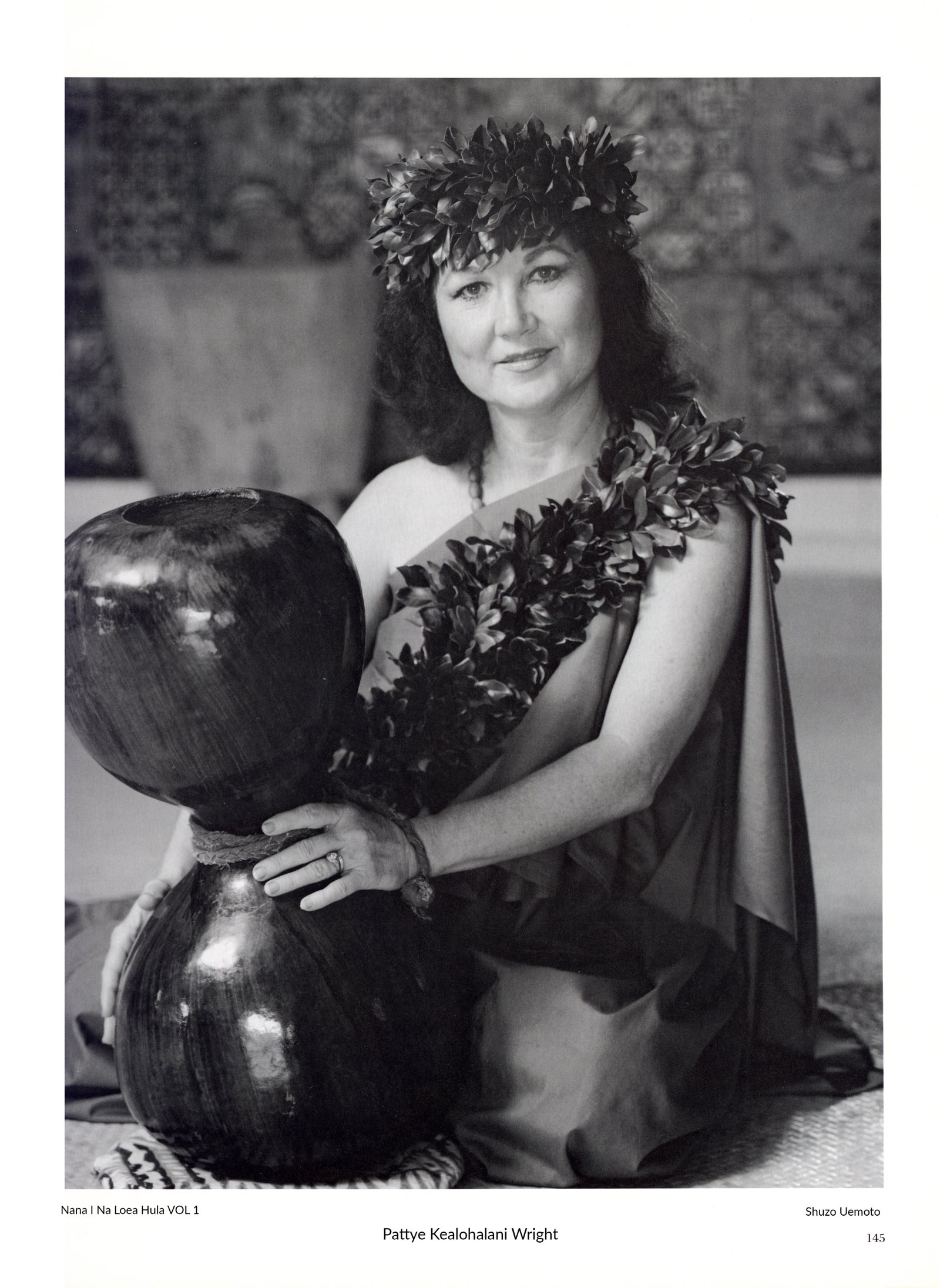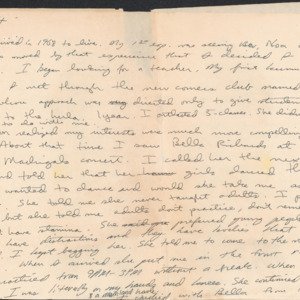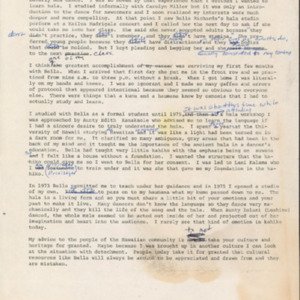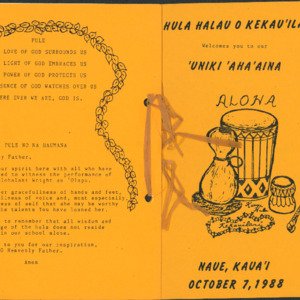Pattye Kealohalani Wright
Title
Pattye Kealohalani Wright
Description
Paltye Kealohalani Wright
Born and raised in Missouri, Pattye Wright arrived in Hawaiʻi fifteen years ago and has taught the hula in Kailua, O‘ahu since 1973.
Bella Richards has been my greatest influence. Her style epitomizes my ideal of hula - very low, very soft, very fluid. The highest compliment I can receive is for someone to approach me after watching my dancers perform and tell me they know that Bella was my kumu hula.
When I arrived in Hawaiʻi in 1968 from the Midwest, my first hula experience was to see Beverly Noa dance. I was so moved by the experience that I decided I wanted to learn the hula. I studied informally with Carolyn Miller as an introduction to the dance for newcomers. Soon I realized my interests were much deeper and more compelling. At this point I saw a performance of the Kailua Madrigals and Bella was introduced as the teacher and choreographer of the group. I was so impressed that I telephoned her the next day to ask if she would take me into her classes. She informed me that she did not accept adults because ‘they don’t practice, they don’t remember, and they don’t have stamina.’ She preferred young people because they didn’t have as many distractions in their lives and because they had bodies that could more readily be molded. I kept pleading and begging until she finally consented to my attending the next class session.
The first great accomplishment of my dancing career was merely surviving my early months with Bella. When 1 arrived that first morning she placed me in the front row with her senior dancers. We practiced from nine a. m. to three p. m. without a break. I was literally on my hands and knees when I got home. I felt so ignorant because of the gaffes and errors of protocol I made - mistakes that seemed so obvious to everyone else. These were things that a kumu and a haumāna know by osmosis but that I had to actually study and learn.
I studied with Bella as a formal student until 1975. It was about this time while attending a hula workshop I was approached by Aunty Edith Kanakaʻole. Aunty Edith advised me that I must learn the language if I had a sincere desire to understand the hula. I spent three years at the University of Hawai‘i studying the Hawaiian language and related subjects. The new knowledge was a revelation for me. I felt like a light had been turned on in a dark room. It clarified many ambiguous, gray areas that had been perplexing to me. The importance of the ancient chants in a hula dancer’s education became very clear. Bella had chosen to teach very little kahiko. I now realized that my hula education was something like a house without a foundation. I wanted the structure that the kahiko could give me so I went back to Bella for her consent. She led me to Lani Kalama with whom I am still privileged to study under. It is Aunty Lani who has given me my foundation in the hula kahiko.
In 1971 Bella permitted me to teach under her guidance and in 1975 she gave me her approval to open a studio of my own. I try to pass on to my haumāna what my kumu passed down to me — that the hula is a living form and you must share a little bit of your emotions and your past to make it live. Too many dancers do not learn the language. They dance their routines mechanically and they kill the life of the song and the life of the hula. When Aunty ‘Iolani (Luahine) danced, the whole mele seemed to be acted out inside of her. She projected her imagination and heart out into the audience and I rarely see that kind of emotion in kahiko today.
My advice to the people of the Hawaiian community is to not take this culture and heritage for granted. Perhaps because I was brought up in another culture I look at the situation with a special concern. Too many people today assume that cultural resources like Bella will always be around to be appreciated and they are mistaken.
Born and raised in Missouri, Pattye Wright arrived in Hawaiʻi fifteen years ago and has taught the hula in Kailua, O‘ahu since 1973.
Bella Richards has been my greatest influence. Her style epitomizes my ideal of hula - very low, very soft, very fluid. The highest compliment I can receive is for someone to approach me after watching my dancers perform and tell me they know that Bella was my kumu hula.
When I arrived in Hawaiʻi in 1968 from the Midwest, my first hula experience was to see Beverly Noa dance. I was so moved by the experience that I decided I wanted to learn the hula. I studied informally with Carolyn Miller as an introduction to the dance for newcomers. Soon I realized my interests were much deeper and more compelling. At this point I saw a performance of the Kailua Madrigals and Bella was introduced as the teacher and choreographer of the group. I was so impressed that I telephoned her the next day to ask if she would take me into her classes. She informed me that she did not accept adults because ‘they don’t practice, they don’t remember, and they don’t have stamina.’ She preferred young people because they didn’t have as many distractions in their lives and because they had bodies that could more readily be molded. I kept pleading and begging until she finally consented to my attending the next class session.
The first great accomplishment of my dancing career was merely surviving my early months with Bella. When 1 arrived that first morning she placed me in the front row with her senior dancers. We practiced from nine a. m. to three p. m. without a break. I was literally on my hands and knees when I got home. I felt so ignorant because of the gaffes and errors of protocol I made - mistakes that seemed so obvious to everyone else. These were things that a kumu and a haumāna know by osmosis but that I had to actually study and learn.
I studied with Bella as a formal student until 1975. It was about this time while attending a hula workshop I was approached by Aunty Edith Kanakaʻole. Aunty Edith advised me that I must learn the language if I had a sincere desire to understand the hula. I spent three years at the University of Hawai‘i studying the Hawaiian language and related subjects. The new knowledge was a revelation for me. I felt like a light had been turned on in a dark room. It clarified many ambiguous, gray areas that had been perplexing to me. The importance of the ancient chants in a hula dancer’s education became very clear. Bella had chosen to teach very little kahiko. I now realized that my hula education was something like a house without a foundation. I wanted the structure that the kahiko could give me so I went back to Bella for her consent. She led me to Lani Kalama with whom I am still privileged to study under. It is Aunty Lani who has given me my foundation in the hula kahiko.
In 1971 Bella permitted me to teach under her guidance and in 1975 she gave me her approval to open a studio of my own. I try to pass on to my haumāna what my kumu passed down to me — that the hula is a living form and you must share a little bit of your emotions and your past to make it live. Too many dancers do not learn the language. They dance their routines mechanically and they kill the life of the song and the life of the hula. When Aunty ‘Iolani (Luahine) danced, the whole mele seemed to be acted out inside of her. She projected her imagination and heart out into the audience and I rarely see that kind of emotion in kahiko today.
My advice to the people of the Hawaiian community is to not take this culture and heritage for granted. Perhaps because I was brought up in another culture I look at the situation with a special concern. Too many people today assume that cultural resources like Bella will always be around to be appreciated and they are mistaken.
Citation
“Pattye Kealohalani Wright,” Nā Kumu Hula Archive, accessed December 13, 2025, https://nakumuhula.org/archive/items/show/90.





